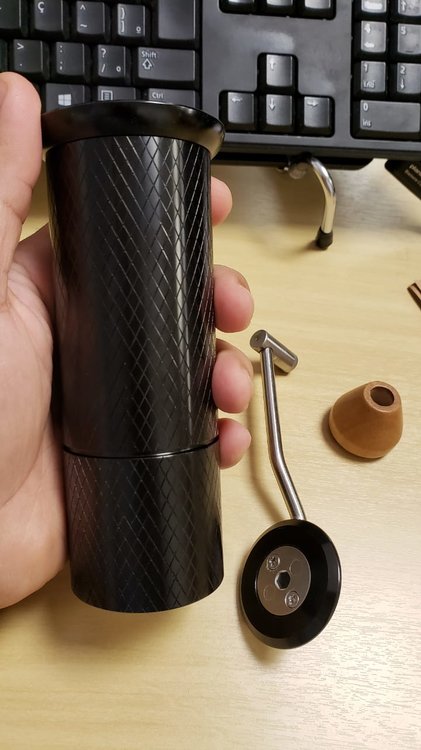Ranking
Conteúdo Popular
Mostrando conteúdo com maior reputação em 06-11-2020 em todas as áreas
-
Eu encontrei um post do criador no reddit, na época da campanha do Kickstarter, segue: raymurakawa·3y Hi, I'm the developer of melodrip. There are a lot of misconceptions on what this product is, so if you're interested here is some info. melodrip was NOT specifically designed to eliminate or minimize agitation. Although it does this very well, agitation is imperative to exposing low-concentration water to soluble coffee compounds and the best way of quickly delivering heat and hydration to the brewbed; so when necessary, this step must not be overlooked. melodrip was developed as tool for reducing particle suspension in the slurry. Period. The current melodrip method aims to minimize the amount of insoluble particulate matter that is discharged from the filter paper. The average median porosity of commercial filter paper has a retention greater than ~30 microns, and is not designed to efficiently retain particles smaller than this. If you refer to coffee grind particle distribution charts, you will see there is a considerable volume of fines equal to and smaller in this range. So when brewing coffee, smaller suspended particles have a higher tendency to be carried along with out-flowing fluid, regardless of technique. The melodrip method at its rough current state, is designed to minimize this discharge of insoluble particles. These particles can adhere to taste receptors and cause a phenomenon called ‘Receptor Blockade’, (m. petracco illycaffe’ ) in which our perception of certain flavors are obscured. This is very simple to examine. Place an evenly mixed sample of coffee into a centrifuge and separate. You will see that coffee filtered with any conventional manual brewer includes insoluble particles. Why so complicated? Why do companies spend millions of dollars investing in multi stage pressure and temperature profiling systems for espresso machines? Or the development of software and automated devices to that maintain temperature curves for roasting? Aside from the financial case of the ROI associated with espresso drinks, the simple answer is-Coffee is complicated. This goes for espresso, ibrik, immersion, filter, nel drip and all brewing methods. The reason why some coffee people complain that coffee is underpriced and undervalued is because they don’t realize it’s potential is far from being untapped. If we are able to express the complexity of this product even further, we can also better translate it's value to the customer. This is a raw product that takes years to grow and harvest to quality standards, and thus takes a lot of attention to prepare until it is a beverage that can be imbibed by the masses. Damn right it’s complicated. Simplifying the preparation of this produce does not happen at the farm, at the roaster, in its education and research, nor should it be done with the tools that are designed to get the most value out of it. If I was satisfied with hitting EYs and TDS to validate coffee’s potential, this would limit my ability to research outside the box and discover unknown perspectives as a tools developer. There are plenty of other developers trying to improve coffee brewers because it’s easy to market and takes little education for the customer. The customer we are interested in, shares our mentality of exploring the undefined. melodrip is still experimental and requires a high learning curve, so if it' used without proper understanding of its intent, it will deliver lackluster results. As a primer, this is how I recommend using melodrip. Each step is developed in coordination of how the brewbed behaves during specific stages of the brewing process. If you have any questions as to why this is the way it is, I’ll be happy to answer! What you need: • Un-Sieved Medium Fine Grind. Recommended to coarse 1 notch finer than usual. • Preferably, a Flat Bottom Brewer. Cone Brewers may require finer grind and can produce excessive transparency even with high tds%. • 15g Coffee • 240g Water • 210f Temp • Med-Fine Grind Preparing the coffee brewbed for extraction: This is the most crucial stage in brewing. Skipping these steps is equivalent to pulling an espresso shot without tamping. Goals: The goal is to saturate slowly to prevent the formation of a foam slurry or floating crust, in which degassing coffee floats above water in a large mass and which minimizes effective hydration. The slow pulse pours will saturate the brewbed and simultaneously dissipate bubbles before diffusion can proceed optimally. 1) Pour water slowly in a circular motion onto melodrip. Pulse 10g water, wait several seconds, add 10g water, wait several seconds, add 10g water. Each time adjusting the location of the dish with the intent of fully saturating the surface of the brewbed. After achieving 2x water:coffee saturation, immediately mix brewbed with the glass stick to eliminate clumps. Mixing with the stick is important as it saturates the bloom evenly. If you skip this step, the slurry may develop channeling during the diffusion phase. Diffusion Phase: Goals: Focus on maintaining the porosity of the brewbed and keep the waterline close to the surface of the brewbed to deliver frequent doses of low concentration water, and maintain an even flowrate. To do this, use the least amount of agitation so fines are rinsed to the bottom depths of the brewbed to promote cake filtration. The reduced agitation will also reduce pressure against the filter wall and minimize particle suspension. Both will help minimize particle discharge. 2) After a 30sec bloom, repeatedly pulse 10g of Water, wait until the waterline lowers to the brewbed surface (3-5sec). Continue to repeat until you hit 200g Water. 3) Finally, Pour 20g Water with a bare kettle. Then pour 20g Water with a bare kettle again to finish off the brew. This final step will help squeeze any leftover compounds from larger particles. After roughly 80% of the brew, bare kettle pouring does not greatly impact the discharge of fine particles out of the filter. Enfim, acabei comprando, está pra chegar em dezembro, vou esperar meu Bravo chegar também para ter uma granulometria mais precisa, dai vou testar: com e sem melodrip usando o Hario e o Bravito pra ter uma noção. Falo dos resultados depois disso abraços!3 points
-
Pessoal, Eu havia comentado aqui no fórum que estava namorando esse moedor uns meses atrás. Acabou que eu comprei o primeiro do Marcos aqui do Fórum e agora adquiri a segunda unidade. Olhando as fotos do anuncio o que me chamava a atenção era o corpo ser todo usinado em alumínio e as mós em inox com eixo com mancais duplos e rolamentado em ambos mancais. Me pareceu uma imitação bem inferior, mas que lembra muito o Comandante. Pelo preço, achei interessante. Como podem ver nas fotos, o moedor é realmente bem robusto e a meu ver (tenho pouca experiencia com outros moedores) uma performance muito boa. Apesar de ter uma excelente construção e já ter alguns meses que estou usando todos os dias, tive um defeito na primeira unidade que foi resolvido por um torneiro mecânico. A parte externa da mós estava girando quando ficava pesado a moagem. Tirando esse detalhe que achei totalmente falta de controle de qualidade dos produtos chineses, o resto da construção é extremamente robusta e acredito que terei moedor para muitos anos. Tanto que comprei o segundo para deixar exclusivamente no trabalho. Pois se tratar de um moedor 100% construído em alumínio é inox, ele pesa em torno de 500grs o que não quero ficar carregando na mochila para um lugar todo dia. Aceitável carregar eventualmente para lugares que vou final de semana por exemplo ou em viagens. Não sei se outros tem interesse, mas espero que ajuda na tomada de decisão de quem tiver em dúvidas. Vou postas mais fotos da mós semana que vem. Att, Felipe1 point
-
Vendo máquina La Pavoni Professional, ano 1996. Comprei a máquina em SP, e ela foi para a casa do Alexandre@cabeca , entre fevereiro e maio, onde foi totalmente restaurada. Combinei com ele uma restauração que não apagasse a idade da máquina, pois não queria uma que tivesse a aparência de que tinha acabado de sair da fábrica. A máquina foi completamente desmontada, a base foi pintada em eletrostática e o boiler e outras peças foram para um banho de cromo. O jogo de vedações é novo, assim como o porta filtro, o braço de vapor, o pressostato e outras peças. Valor 5.300,00 reais. A máquina se encontra em Tubarão, Santa Catarina, e o frete é por conta do comprador. Seguem fotos. Enviado de meu MI 8 Lite usando o Tapatalk1 point
-
@Igor e @Luis Paulo, Vocês mudaram os rumos do cenário de torra doméstica do Brasil! Todo sucesso à ROAST e aos novos passos. Também aproveito a brecha para agradecer ao @Allexlimaa2, um dos incentivadores e motivos de eu estar torrando hoje! Vida longa ao CdC!1 point
-
Amigos, minha Perfect Brew Chegou... demorei umas 3 extrações para "acertar" a pegada, foi bem rápido. Ainda não sei fazer Latte Art, vai demorar pra eu aprender a fazer isso direito. Vim de uma Oster Prima Latte 2 + Moedor Tramontina Breville. O moedor da Tramontina é melhor pois dá mais flexibilidade (de fazer outras níveis de moagem). O Moedor da Prima Latte é basicamente para espresso, talvez fino o suficiente para um Turco... e grosso o suficiente para V60/Coado. Tenho um Pour Over de metal... acho que na moagem 30 fica no limite para usar o mesmo. Comprei os seguintes acessórios: Esse Leveler eu gostei bastante: Recomendo! Vou tentar só usar o nivelador e não prensar meus espressos... tem um monte de Barista que trabalha assim, quem sabe assim eu ganhe mais consistência nas extrações! https://www.aliexpress.com/item/Espresso-304-Stainless-Steel-51mm-58mm-Coffee-Distributor-Leveler-Tool-Macaron-Coffee-Tamper-with-Three-Angled/4001316434373.html?spm=a2g0s.9042311.0.0.3d33b90aOsWmpl Já esse funil se "levanta" ao encostar o cachimbo no moedor... já derrubei o funil uma vez por causa disso. Dá pra usar... mas não ficou 100%. https://www.aliexpress.com/item/Aluminum-IDR-Intelligent-Dosing-Ring-For-Brewing-Bowl-Coffee-Powder-Espresso-Barista-Tool-For-58-51/32958865536.html?spm=a2g0s.9042311.0.0.3d33b90aOsWmpl Vamo que vamo!1 point
-
Se você tiver conta no Banco Inter consegue mais um cashback acessando o Submarino (ou outra loja parceira do banco) pelo shopping dentro do app, e lá o cashback é dinheiro de verdade que você pode usar pra qualquer coisa até sacar. Hoje está dando 3% mas já vi 5, 6, 8, até 10%, com a Black Friday se aproximando eles devem aumentar pra chamar clientes. Só dão a dica de esvaziar o carrinho e recomeçar a compra do 0 pra garantir (ao acessar a loja pelo link do Inter). Comigo funcionou na época que comprei.1 point
-
Isso é tão irrelevante perto do preço/prazer/funcionalidade que você vai ter... A real é que a internet e fóruns acabam amplificando esses detalhes que passariam despercebidos para 99% das pessoas. Enquanto essa discussão rola eu já fiz uma dezena de ótimos cafés... :-) Enviado de meu SM-G9650 usando o Tapatalk1 point





.thumb.jpeg.68cb616b384d5cbd15225ef9995081ca.jpeg)
.thumb.jpeg.71f0e70a111bb162c02b095c4a5239f5.jpeg)
.thumb.jpeg.8df79adb761868b9395c742e9d0ae930.jpeg)
.thumb.jpeg.f927e50cfc747e10151e155b016f6c0f.jpeg)
.thumb.jpeg.5daaee6f5d2cb47eb1d44879a88a6680.jpeg)
.thumb.jpeg.2fba193f6b6fde1a573e8776b56422fa.jpeg)
.thumb.jpeg.7bfcf38afa981da177ce6f6ec250fcbd.jpeg)

